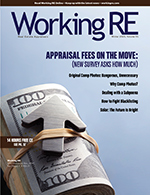 |
“One of the best courses that I have had in 17 years!” -Amy H
>> OREP E&O |
Editor’s Note: Take the NEW 2021 Appraiser Fee Survey online now at WorkingRE.com/2021survey.
Institutional Memory and Appraiser Firms
by Richard Hagar, SRA
Institutional memory, having “old farts” working with younger appraisers, that’s where the profit is today. Find those who have the experience and figure out how to work with or for them to make your life easier and more profitable. Here’s why that is so.
Institutional memory can be defined as a collective set of facts, concepts, experiences and knowledge held by a group of people. Wikipedia explains the concept as: Adaptations developed over time and taught to new members of the group, keeping them from encountering the same problems and having to develop a solution that already exists.
In this way, organizations save time and resources that might otherwise be wasted. In our context, it might mean a veteran appraiser or appraisers helping a newbie deal with changes impacting business.
Example: If everyone at an appraisal firm quit at once, the employees hired to replace them would not be able to benefit from the previous group’s collective experience. They would make many of the mistakes the group of experienced appraisers now avoid. The firm would have lost some or all of its institutional memory and would operate less efficiently.
The appraisal business today is experiencing significant changes—inspection issues, new appraisal processes, conflicting certifications, and of course—fear. Appraisers are asking me on a daily basis:
• “Do you have a class that teaches how to perform a drive-by or desktop appraisal?”
• “Can I use a 1004 for a drive-by appraisal?”
• “If the lender requires an interior inspection and I don’t want to go inside…..can I be forced to inspect the interior?”
• “The 1004 Certification states that ‘I inspected’ but if I do a desk appraisal I haven’t inspected it, now what?”
• “If I don’t inspect, where do I get information regarding the property’s quality and condition?”
• “Should I still provide a cost approach when I don’t inspect?”
• “Where do I get information regarding these new appraisal processes?” And dozens of other questions.
Scope of Work
First, desktop and drive-by appraisals are not new. For decades Fannie Mae has had forms for these types of appraisals. For even longer the Appraisal Institute has taught classes explaining different scope of work scenarios, all of which are useful during these changing times. The problem is that most “newish” appraisers working on their own have never experienced issues like what we are dealing with today, and as a result they don’t know where to turn for answers. This is where institutional memory (experienced peers) would normally come into play. The can help apply sound appraising principles to new challenges.
At the core of these questions and issues is the scope of work. Scope of work isn’t which form you use—it’s how much work you put into the appraisal process and how much information you convey to the client. What is the level of research? What information sources were used; which were not used; did you get information from the owner, agent, past appraisal, MLS, and/or county or client? How much effort did you put into confirming information and adjustments? Did you measure the building or rely on the county or third-party? Did you sit on your tush in the office or personally inspect—from inside or the nearest street?
All of these, and many other questions and explanations, are part of your scope of work. What did you do to produce a credible report? The form you use to convey information to your client is a minor part of this process. More important is—what does your Certification state that you did? And did you really do what is in the Certification? I strongly suggest you carefully read the Certification in the current 1004 appraisal and FNMA’s new Certification designed for the level of inspection we are using today. Taking a class that explains the scope of work process and other topical issues is vital to every appraiser. It is a way to achieve “institutional memory” that you may have missed.
The Solo Appraiser
Over the last decade or so, the prominence of AMCs has caused many appraisal firms to splinter into one person shops. With AMCs taking their cut—often half—there often isn’t enough left for an appraiser to share with a “firm.” But many of the appraisers going out on their own have not developed much institutional memory. Appraisers keep more of their fee by going solo, yes. But newer appraisers, and most AMCs, don’t have the experience or institutional memory to navigate the issues we are all facing today. So, at the end of the day, the quest to avoid splitting a fee has caused some appraisers to operate less efficiently and less profitably.
Appraising Business
The business of appraising is much more than simply filling out an appraisal form, there is: A) advertising and obtaining the business—marketing B) running the business and C) doing the business (providing appraisals). Each of these segments requires separate job skills, focus and time… lots of time. If you are tracking the money or obtaining new clients, you are not researching, inspecting and writing appraisals. Bouncing between three different business segments reduces efficiency and profit. This is hard for a solo appraiser. The advantage of working in a larger office, with a mix of experienced and inexperienced appraisers, is that the experienced appraisers or office managers can provide the institutional memories necessary to handle the situations we are facing—whereas many AMCs cannot. Seasoned appraisers should have the answers that allow less experienced appraisers to quickly adapt and profit in the crazy business cycle we are in. You can enjoy the benefits of institutional memory, reduce/shift your workload and grab a bigger share of appraisal assignments from clients who are willing to pay the highest fees.
Figure out how to work in a larger office or alternatively, how several independent appraisers can work in the same space (once social distancing restrictions are lifted). Figure out how to share expenses associated with office rent, file storage, bookkeeper, accounts payable & collections, payroll, software, a professional receptionist, phone systems, construction cost services, and most importantly, knowledge about the good clients and the bad clients with a history of under or slow paying. Even if you run your one-person shop out of a shared space, there will be others around who you can ask questions to and learn from. Sharing experiences is the path toward greater learning, adaptability, and profit.
Two suggestions
How about rotating management between three partners; each month one of the owners is “the boss” running the office and helping the other appraisers. Because the “boss of the month” is completing fewer appraisals, they are paid five to 10 percent of the total business income month. Next month another owner is selected to run the office. As an alternative, maybe each owner runs a different segment of the business based on their strengths: A) marketing B) managing C) reviewing D) bank appraisals E) complex appraisals. There are dozens of different versions of this that could be employed. Figure out which business path works best for you and how to divide the workload, increase institutional memory and profits.
In my office I’ve been through several downturns and learned to provide a wide range of appraisal products with different scopes of work. We learned to adapt and overcome. Once lenders started asking us for drive-by appraisals I already had, with a little tweaking, we had the Certifications necessary for the appraisal services our clients were asking for.
We already knew that the cost approach would be included in the appraisal (desk, drive-by, or inspection), and most importantly, that our appraisal fee would be equal to, if not higher than a “normal” 1004 type of appraisal. Providing a drive-by appraisal still requires support for the adjustments, researching the current market and reliance on information from others, all of which must be explained in the appraisal. The fees we are being offered today are $900+ for a “typical” 1004 appraisal on a “standard” home. Why? Because while other appraisers have to search for answers or tell their clients “no” or “I won’t/can’t do that,” we adapted and were able to tell our clients in many cases—yes we can and here’s how. Wouldn’t that feel good?
Lenders are desperate for someone to competently appraise properties for their loans and those with institutional memory can provide solutions. Prepare yourself so you can fill the need.
About the Author
Richard Hagar, SRA, is an educator, author and owner of a busy appraisal office in the state of Washington. Hagar now offers his legendary adjustments course for CE credit in over 30 states through orepeducation.org. The new 7-hour online CE course “How to Support and Prove Your Adjustments” shows appraisers proven methods for supporting adjustments. Learn how to improve the quality of your reports and defend your adjustments! OREP insureds save on this approved coursework. Sign up today at www.OREPEducation.org.
Sign Up Now! $119 (7 Hrs)
OREP Insured’s Price: $99
>Opt-In to Working RE Newsletters
>Shop Appraiser Insurance
>Shop Real Estate Agent
Insurance
Send your story submission/idea to the Editor:
isaac@orep.org




by David Tomasini
Mr. Hager I am calling you out!!!
-This is my last year of a 32 year Appraisal career and this is the 1st time I have ever replied to this type of forum. I have spent most of my career as an expert witness and base my compensation on Hourly Earned Income. As I was gleaning the above narritive I noticed, being the capitalist that I am, a declaration stating that “we are being offered today a $900 fee for a standard home on a typical 1004”. Now in my world the term “fee” is is meaningless. Let’s do the math….Let’s say it takes you 3hrs per assignment at $900 = $300 per hour…this is quite good…6hrs @ $900 per = $150 per hour…not bad but has room for improvement…9hrs @ $900 per = $100…this is what a “lead hand” construction foreman makes. So Mr. Hager….Are you in the “Quite Good” group or are you going to buy some nail bags this weekend??
I realize that you probably receive quite a few reply’s and I will understand if you don’t have the time to answer an Old Appraiser with fading “Institutional Memory”. However, like I used to tell my interns no adjustment is actually an adjustment. Does this also apply to your reply or lack thereof ? Thanks and keep up the good work.